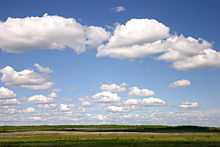Bristol Bay


Bristol Bay (Iilgayaq in Central Yup'ik) is the eastern-most arm of the Bering Sea, at 57° to 59° North 157° to 162° West in Southwest Alaska. Bristol Bay is 400 km (250 mi) long and 290 km, (180 mi) wide at its mouth. A number of rivers flow into the bay, including the Cinder, Egegik, Igushik, Kvichak, Meshik, Nushagak, Naknek, Togiak, and Ugashik.
Upper reaches of Bristol Bay experience some of the highest tides in the world. One such reach, the Nushagak Bay near Dillingham and another near Naknek in Kvichak Bay have tidal extremes in excess of 10 m (30 ft), ranking them — and the area — as eighth highest in the world. This, coupled with the extreme number of shoals, sandbars and shallows, makes navigation troublesome, especially during the area's frequently strong winds. As the shallowest part of the Bering Sea, Bristol Bay is one of the most dangerous areas for large vessels.
History

In ancient times, much of Bristol Bay was dry and arable, along with much of the Bering Sea Land Bridge. More recently, its proximity to mineral, animal and seafood riches provided incentive for human habitation along its shoreline. Early Russian and English exploration provided most of the non-native influences of the area. During his voyage through the area in 1778, the famed British navigator and explorer, Captain James Cook named the area "in honor of the Admiral Earl of Bristol" in England.

After establishing some temporary settlements in the late 1790s, The Russian American Company sent exploratory parties to document the coast and nearby inland areas of Bristol Bay. One of these charted the area between the Kuskokwim and Nushagak Rivers. Later, in 1819, an Aleut by the name of Andrei Ustiugov drew the first intensive charts of Bristol Bay. Additionally, ships of the Russian Navy conducted extensive surveys of the Bering Sea coastline into the mid-19th century, naming many of the geographical features commonly used today: Capes Constantine, Chichagof, Menshikof and Greig, Mounts Veniaminof and Pavlof, Becharof Lake, etc.
Industry

Bristol Bay is home to the world's largest sockeye salmon fishery as well as strong runs of chum salmon, silver salmon and king salmon, each occurring seasonally. Kings are usually the first to run up the river followed by reds and chums. Silvers and Pinks are the last to run up the river.

Major industries are commercial fishing and the associated canneries, sport fishing, hunting and tourism. The number of commercial lodges, hunting- and fishing-resorts and visitors to the nearby Katmai National Park and Preserve has grown exponentially in recent years.
The area has also experienced significant interest in oil and mineral development, most notably with the proposed Pebble Mine on the north shore of Iliamna Lake, and auctioning of leases to tracts in the southern Bristol Bay area known as the North Aleutians Basin, an area which has been closed to offshore oil and gas development since a moratorium in 1998. The draft plan by the Bureau of Land Management (pending public comments until 2/5/2007), also proposes to open most of the BLM's 3.6 million acres (15,000 km²) in the area to hard rock mining and oil and gas drilling.
Demographics

The three largest communities of the Bristol Bay area are Dillingham, King Salmon, and Naknek. Smaller communities which dot the coastline and rivers of Bristol Bay include: Egegik /ˈɪɡɛɡɪk/, Ekuk /ˈɛkoʊk/, Igiugig /ˈɛdʒiːˈjɔːɡɪɡ/, Manokotak /mɑːnəˈkoʊtɑːk/, New Stuyahok /ˈstuːjəhɒk/, Newhalen, Nondalton, Pilot Point, Port Heiden, Ugashik (/juːˈɡæʃɪk/, and South Naknek.
All of these communities are primarily inhabited by Alaska Natives, except for Dillingham, Alaska and King Salmon, Alaska; the former being influenced early-on by white salmon-cannery employees of European descent and the latter being heavily populated by military personnel stationed, primarily during Cold War years, at the nearby King Salmon Air Force Station and later by visitors and employees of the nearby Katmai National Park and Preserve.
Proposed Pebble Mine
A mineral exploration project investigating a large porphyry copper, gold, and molybdenum deposit in the Bristol Bay region has been proposed and may be undertaken by British-Australian [citation needed] Rio Tinto Group and Japanese [citation needed] conglomerate Mitsubishi. Because of the estimated 10 billion tons of mining waste that must be permanently stored in the area, which is an active earthquake zone, and Rio Tinto's environmental track record, which is seen as poor by many environmental advocacy groups, fears have been raised about the potential impact on the Bristol Bay area and its wildlife and residents. In April 2003, Environmental Protection Agency issued an assessment of the impact of the proposed mining operations on fisheries, wildlife and native Alaska tribes. [1]
See also
- Bristol Bay Borough
- Lake and Peninsula Borough
- Naknek, Alaska
External links
| Wikimedia Commons has media related to Bristol Bay. |
- Lake & Peninsula Borough
- Bristol Bay Borough
- Lake and Peninsula School District
- Bristol Bay Alliance
- Bristol Bay Native Association
- Save Bristol Bay
- Renewable Resources Coalition
- Bristol Bay Wild
Technical Reports
- Abundance, age, sex, and size statistics for Pacific herring in the Togiak district of Bristol Bay, 2004 / by Chuck Brazil. Hosted by the Alaska State Publications Program
- Mineral Investigations in the Bristol Bay Mining District Study Area, Southwest Alaska Bureau of Land Management
References
Coordinates: 57°19′35″N 159°49′29″W / 57.32639°N 159.82472°W